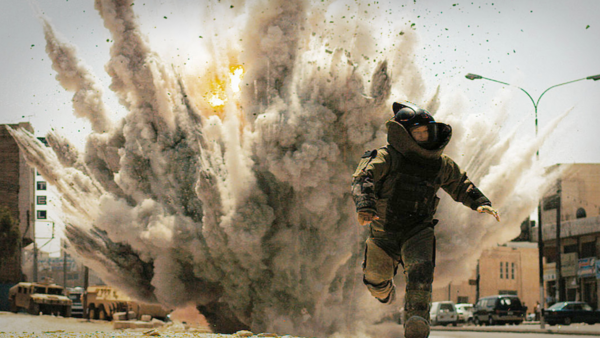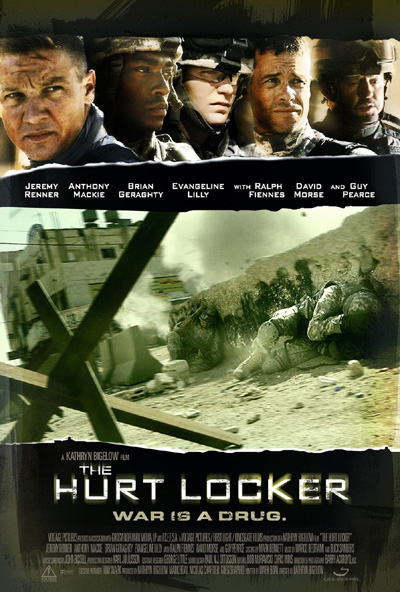Mladen and Del review ‘The Hurt Locker’

Image courtesy of Summit Entertainment.
—
“The Hurt Locker” Starring Jeremy Renner, Anthony Mackie, Brian Geraghty. directed by Kathryn Bigelow. 131 minutes. Rated R.
Mladen’s take
It hurt me a couple of weeks ago when “The Hurt Locker” won the best picture Oscar. That’s two of the past three years that the wrong film took the most important Academy Award.
Director Kathryn Bigelow has created, at best, a mediocre product. “The Hurt Locker” lacks emotion. Its tension is contrived because it results from poor choices by the movie’s leading character.
The film also lacks charisma despite Bigelow mimicking the formula used by Oliver Stone in “Platoon,” which did deserve the best picture Oscar for its depiction of the Vietnam war.
“The Hurt Locker” follows a three-man Army explosive ordnance disposal team through the dusty, brown streets of some Iraqi city.
Jeremy Renner, as William James, plays the role of the reckless, uncompromising staff sergeant commanding the EOD unit. Second-in-charge Sgt. J.T. Sanborn, portrayed by Anthony Mackie, is sensible and risk-aversive.
Sanborn prefers sending robots to defuse IEDs. James, on the other extreme, enjoys tinkering face-to-face with a trunk full of 152-mm rounds wired to blow.
Caught between the two stereotypical soldiers is the trio’s third man, Brian Geraghty, playing Specialist Owen Eldridge.
Eldridge, uncomfortable with the idea of killing and jittery in combat, is the equivalent of Charlie Sheen’s character in “Platoon.” James and Sanborn are hybrids of the two squad leaders in “Platoon” played by Tom Berenger and Willem Dafoe.
Berenger, Dafoe, and Sheen, in that order, made “Platoon” a potent movie very effectively summarizing the absurdity of a war that also was domestically unpopular.
In “The Hurt Locker,” all Bigelow managed to do was create unlikable characters who failed to provoke sympathy. To me, it would have matter almost nothing if James, Sanborn, or Eldridge died, though it was the fault of an inept presidency and rubber-stamp Congress that they were fighting in Iraq.
The movie’s most bitter disappointment happens about halfway through its 131 minutes.
While trying to help mercenaries change a flat tire, the trio unexpectedly finds itself in a sniper’s duel. James and Sanford, though trained as bomb disposers, are stunningly capable as a shooter and spotter, respectively.
They calmly, coolly, expertly, take up prone positions behind a .50-caliber sniper rifle to start searching for targets.
At one point, Sanford, deftly coached by James, nails an insurgent with a headshot at 850 yards (2,550 feet) through a desert haze. Oh, the insurgent was running across Sanford’s field of view when he took the 1-ounce slug. Oh, moments earlier, Sanford had missed the very same insurgent while he was lying on the ground and not moving.
“The Hurt Locker” offers nothing that hasn’t been provided by other war movies. And, it sheds no fresh or thought-provoking perspective on the Iraq war or its affect on American soldiers.
I want a recount. “District 9” must have been the real winner of the Oscar for best picture.

Del’s take
I take it from Mladen’s review “The Hurt Locker” was an OK movie that didn’t deserve a best picture Oscar.
No arguments there. Well … a few.
I liked the movie better than Mladen but agree it was flawed. The quibbles include fakey explosions that never seem to match the ferocity of IED blasts depicted in actual footage, and fakey combat scenarios that allow a guy with a sniper rifle to pick off a running man at a thousand yards. I can’t suspend my disbelief.
I thought the movie’s biggest weakness, however, lay in its structure. The viewpoint character, played by Renner, craves the adrenaline cocktail of ordnance disposal and the risk of death his job presents. We see a brief glimpse of his other life back home – he’s confounded and ultimately bored by the cereal selections at a supermarket – and discover he’s a bonafide war addict. To appreciate the yin and the yang of his lust we must experience both sides equally, yet nine-tenths of “The Hurt Locker” takes place in Iraq, depriving the audience of any feel for the character and his conflicts.
Still, “The Hurt Locker” is a good movie, and Renner absolutely deserved the Oscar nomination he received for best actor.
But was “The Hurt Locker” the best movie of 2009?
No, no and no.
Instead of re-treading ground already covered by Mladen I’d like to talk about the possible machinations that led to “The Hurt Locker’s” ordination as best picture.
Machination No. 1: the award.
For a creator, winning an award is money in the bank. You win an award and people who haven’t seen your product want to see it. They rent it, they buy it, and sometimes they steal it. But to win that award you must do something we writers call “campaigning.” You woo the support of those who nominate your product, trade favors, advertise, and send out e-mails – which notoriously backfired with “The Hurt Locker.”
I did this as a writer in the late 1990s and early 2000s.
Campaigning is an ugly mess, one of the reasons I dropped my memberships with groups like the Science Fiction Writers of America and the Horror Writers Association. It made me feel dishonest. After all, shouldn’t the best product win?
That’s the theory, but in reality the product most effectively campaigned often wins.
Machination No. 2: politics.
Groups that hand out awards, like the Academy of Motion Picture Arts and Sciences, keep a close eye on political expediency. They want to be seen as forward-thinking and progressive, and at the same time they want to reward fealty to their artistic vision … with a wee eye kept on the bottom line. How else to explain John Wayne’s Oscar score for “True Grit”?
When rumblings were heard that no woman had won an Academy Award for best director, and that maybe the Academy wasn’t as forward-thinking as it wanted to be known, along comes Kathryn Bigelow with “The Hurt Locker.” Coincidence? I think not.
Which leads me to Machination No. 3: the snub.
No individual can be bigger than the machinery supporting that individual … unless you’re George Lucas, Steven Spielberg, or James Cameron. But even those pillars of the moviemaking community must have their noses tweaked ever so often just to let them know who’s boss.
Cameron has produced the two biggest movie blockbusters of the past 11 years – “Avatar” and “Titanic.” In 1998 Cameron declared himself “king of the world” during his Oscar acceptance speech for best director of “Titanic.”
Word on Hollywood Boulevard is that Cameron is an ass to work for. He’s egocentric, abusive and dismissive of the Tinsel Town Machine, qualities that might endear him to ordinary Americans but would not play well with the rarefied and elitist company of Hollywood movers and shakers. What better way to bring Cameron down a notch than to give the best director award to his former wife, Kathryn Bigelow, who directed a movie at a tiny fraction of Cameron’s “Avatar” budget?
Obviously I can’t know what really happened. But having played the game for so many years I suspect merit had little to do with the outcome. A combination of politics, ego-mashing and campaigning resulted in “The Hurt Locker” being named the best picture of 2009.
There might be a fourth reason – plain old disdain for that which is popular. The publishing industry is particularly notorious for supporting obscure, obtuse products over those which pay the bills. John Grisham won’t win a Pulitzer Prize but he allows the college professor who does a fighting chance to claim a mainstream audience.
My definition of “best movie” consists of a simple rubric: the film that sold the most tickets. “The Hurt Locker” didn’t do that and frankly I don’t trust the judgment of those who say it was better than its box-office performance.
By all means rent “The Hurt Locker.” But don’t expect any epiphanies. On a five-star scale it rates a 3½ – not a waste of your money but certainly not best picture of 2009.
Mladen Rudman is a former journalist and technical editor. Del Stone Jr. is a former journalist and author.
![]()
Leave a Reply